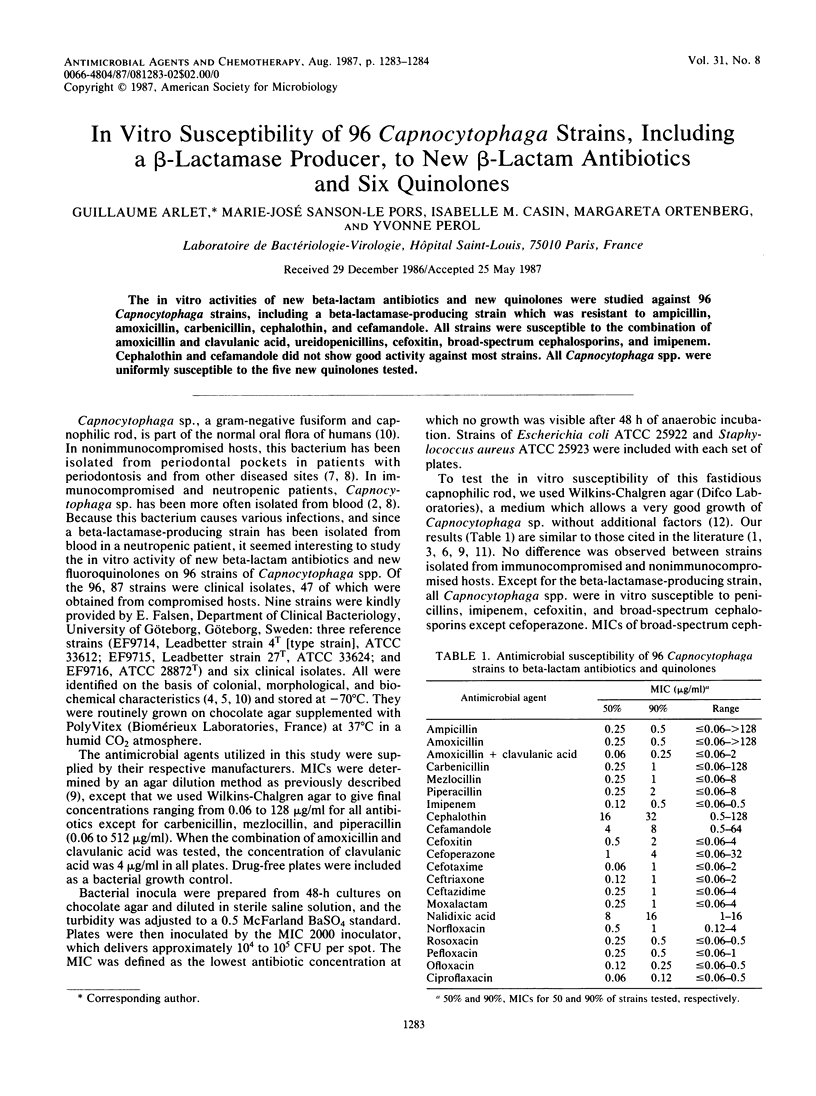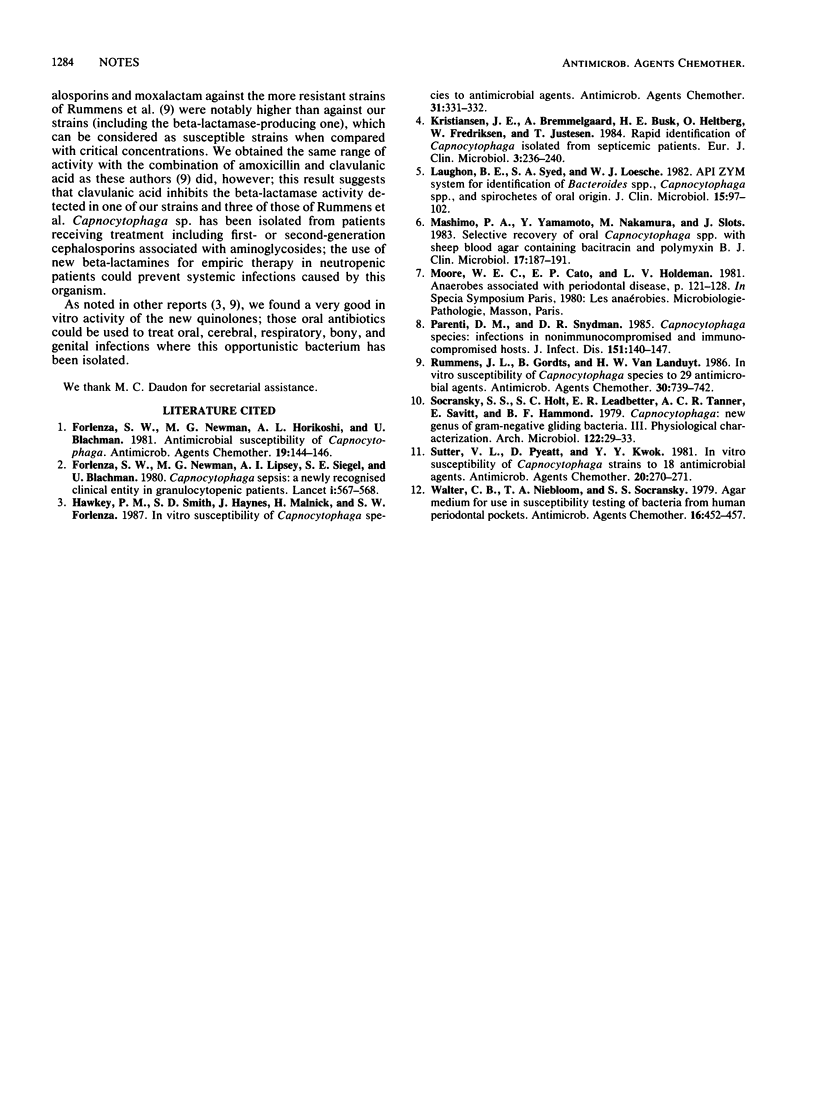Abstract
The in vitro activities of new beta-lactam antibiotics and new quinolones were studied against 96 Capnocytophaga strains, including a beta-lactamase-producing strain which was resistant to ampicillin, amoxicillin, carbenicillin, cephalothin, and cefamandole. All strains were susceptible to the combination of amoxicillin and clavulanic acid, ureidopenicillins, cefoxitin, broad-spectrum cephalosporins, and imipenem. Cephalothin and cefamandole did not show good activity against most strains. All Capnocytophaga spp. were uniformly susceptible to the five new quinolones tested.
Full text
PDF

Selected References
These references are in PubMed. This may not be the complete list of references from this article.
- Forlenza S. W., Newman M. G., Horikoshi A. L., Blachman U. Antimicrobial susceptibility of Capnocytophaga. Antimicrob Agents Chemother. 1981 Jan;19(1):144–146. doi: 10.1128/aac.19.1.144. [DOI] [PMC free article] [PubMed] [Google Scholar]
- Forlenza S. W., Newman M. G., Lipsey A. I., Siegel S. E., Blachman U. Capnocytophaga sepsis: a newly recognised clinical entity in granulocytopenic patients. Lancet. 1980 Mar 15;1(8168 Pt 1):567–568. doi: 10.1016/s0140-6736(80)91057-0. [DOI] [PubMed] [Google Scholar]
- Hawkey P. M., Smith S. D., Haynes J., Malnick H., Forlenza S. W. In vitro susceptibility of Capnocytophaga species to antimicrobial agents. Antimicrob Agents Chemother. 1987 Feb;31(2):331–332. doi: 10.1128/aac.31.2.331. [DOI] [PMC free article] [PubMed] [Google Scholar]
- Kristiansen J. E., Bremmelgaard A., Busk H. E., Heltberg O., Frederiksen W., Justesen T. Rapid identification of Capnocytophaga isolated from septicemic patients. Eur J Clin Microbiol. 1984 Jun;3(3):236–240. doi: 10.1007/BF02014892. [DOI] [PubMed] [Google Scholar]
- Laughon B. E., Syed S. A., Loesche W. J. API ZYM system for identification of Bacteroides spp., Capnocytophaga spp., and spirochetes of oral origin. J Clin Microbiol. 1982 Jan;15(1):97–102. doi: 10.1128/jcm.15.1.97-102.1982. [DOI] [PMC free article] [PubMed] [Google Scholar]
- Mashimo P. A., Yamamoto Y., Nakamura M., Slots J. Selective recovery of oral Capnocytophaga spp. with sheep blood agar containing bacitracin and polymyxin B. J Clin Microbiol. 1983 Feb;17(2):187–191. doi: 10.1128/jcm.17.2.187-191.1983. [DOI] [PMC free article] [PubMed] [Google Scholar]
- Parenti D. M., Snydman D. R. Capnocytophaga species: infections in nonimmunocompromised and immunocompromised hosts. J Infect Dis. 1985 Jan;151(1):140–147. doi: 10.1093/infdis/151.1.140. [DOI] [PubMed] [Google Scholar]
- Rummens J. L., Gordts B., Van Landuyt H. W. In vitro susceptibility of Capnocytophaga species to 29 antimicrobial agents. Antimicrob Agents Chemother. 1986 Nov;30(5):739–742. doi: 10.1128/aac.30.5.739. [DOI] [PMC free article] [PubMed] [Google Scholar]
- Socransky S. S., Holt S. C., Leadbetter E. R., Tanner A. C., Savitt E., Hammond B. F. Capnocytophaga: new genus of gram-negative gliding bacteria. III. Physiological characterization. Arch Microbiol. 1979 Jul;122(1):29–33. doi: 10.1007/BF00408042. [DOI] [PubMed] [Google Scholar]
- Sutter V. L., Pyeatt D., Kwok Y. Y. In vitro susceptibility of Capnocytophaga strains to 18 antimicrobial agents. Antimicrob Agents Chemother. 1981 Aug;20(2):270–271. doi: 10.1128/aac.20.2.270. [DOI] [PMC free article] [PubMed] [Google Scholar]
- Walker C. B., Niebloom T. A., Socransky S. S. Agar medium for use in susceptibility testing of bacteria from human periodontal pockets. Antimicrob Agents Chemother. 1979 Oct;16(4):452–457. doi: 10.1128/aac.16.4.452. [DOI] [PMC free article] [PubMed] [Google Scholar]


